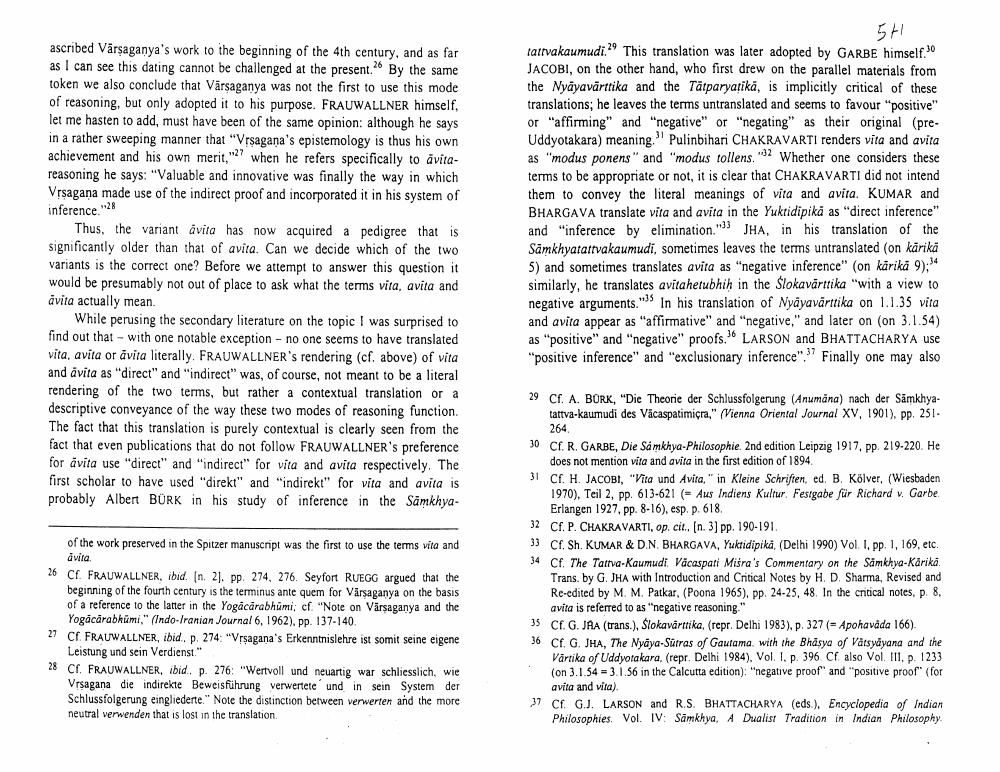Book Title: Avita And Avita Author(s): Eli Franco Publisher: Eli Franco View full book textPage 5
________________ 5+ ascribed Värsaganya's work to the beginning of the 4th century, and as far as I can see this dating cannot be challenged at the present. By the same token we also conclude that Vārsaganya was not the first to use this mode of reasoning, but only adopted it to his purpose. FRAUWALLNER himself, let me hasten to add, must have been of the same opinion: although he says in a rather sweeping manner that "Vrsagana's epistemology is thus his own achievement and his own merit," when he refers specifically to avitareasoning he says: "Valuable and innovative was finally the way in which Vrsagana made use of the indirect proof and incorporated it in his system of inference, 28 Thus, the variant avita has now acquired a pedigree that is significantly older than that of avita. Can we decide which of the two variants is the correct one? Before we attempt to answer this question it would be presumably not out of place to ask what the terms vita, avita and avita actually mean. While perusing the secondary literature on the topic I was surprised to find out that - with one notable exception - no one seems to have translated vita, avita or avita literally, FRAUWALLNER's rendering (cf. above) of vita and avita as "direct" and "indirect" was, of course, not meant to be a literal rendering of the two terms, but rather a contextual translation or a descriptive conveyance of the way these two modes of reasoning function. The fact that this translation is purely contextual is clearly seen from the fact that even publications that do not follow FRAUWALLNER's preference for avita use "direct" and "indirect" for vita and avita respectively. The first scholar to have used "direkt" and "indirekt" for vita and avita is probably Albert BÜRK in his study of inference in the Samkhya tattvakaumudi." This translation was later adopted by GARBE himself." JACOBI, on the other hand, who first drew on the parallel materials from the Nyāyavärttika and the Tätparyatika, is implicitly critical of these translations; he leaves the terms untranslated and seems to favour positive" or "affirming" and "negative" or "negating" as their original (preUddyotakara) meaning." Pulinbihari CHAKRAVARTI renders vita and avita as "modus ponens" and "modus tollens.)? Whether one considers these terms to be appropriate or not, it is clear that CHAKRAVARTI did not intend them to convey the literal meanings of vita and avita. KUMAR and BHARGAVA translate vita and avita in the Yukridipika as direct inference" and "inference by elimination. JHA, in his translation of the Samkhyatattvakaumudi, sometimes leaves the terms untranslated (on karika 5) and sometimes translates avita as "negative inference" (on kariká 9);" similarly, he translates avitaherubhih in the Slokavārttika "with a view to negative arguments. In his translation of Nyayavärttika on 1.1.35 vita and avita appear as "affirmative" and "negative," and later on (on 3.1.54) as positive" and "negative" proofs. LARSON and BHATTACHARYA use "positive inference" and "exclusionary inference". Finally one may also of the work preserved in the Spitzer manuscript was the first to use the terms vita and avita. 26 Cf. FRAUWALLNER, ibid. In. 21. pp. 274, 276. Seyfort RUEGG argued that the beginning of the fourth century is the terminus ante quem for Vårsaganya on the basis of a reference to the latter in the Yogācārabhumi; cf. "Note on Värsaganya and the Yogacarabkümi," (Indo-Iranian Journal 6, 1962), pp. 137-140. 27 Cf. FRAUWALLNER, ibid. p. 274: "Vrsagana's Erkenntnislehre ist somit seine eigene Leistung und sein Verdienst." 28 Cf. FRAUWALLNER, ibid. p. 276: "Wertvoll und neuartig war schliesslich, wie Vrsagana die indirekte Beweisführung verwertete und in sein System der Schlussfolgerung eingliederte." Note the distinction between verwerten and the more neutral verwenden that is lost in the translation 29 Cf. A. BORK, "Die Theorie der Schlussfolgerung (Anumana) nach der Samkhya tattva-kaumudi des Vacaspatimicra." (Vienna Oriental Journal XV, 1901), pp. 251. 264 30 CE.R. GARBE, Die Sámkhya-Philosophie. 2nd edition Leipzig 1917, pp. 219-220. He does not mention vita and avita in the first edition of 1894 31 Cf. H. JACOBI, "Vita und Avita," in Kleine Schriften, ed. B. Kõlver, (Wiesbaden 1970), Teil 2, pp. 613-621 (= Aus Indiens Kultur. Festgabe für Richard v. Garbe Erlangen 1927, pp. 8-16), esp. p. 618. 32 Cf. P. CHAKRAVARTI, op. cit., (n. 3) pp. 190-191. 33 Cf. Sh. KUMAR & D.N. BHARGAVA, Yuktidipika. (Delhi 1990) Vol. I, pp. 1, 169, etc. 34 Cf. The Tattva-Kaumudi Vacaspati Misra's Commentary on the Samkhya-Karika Trans. by G. JHA with Introduction and Critical Notes by H. D. Sharma, Revised and Re-edited by M. M. Patkar, (Poona 1965), pp. 24-25, 48. In the critical notes, p. 8. avita is referred to as "negative reasoning. 35 Cf. G. JAA (trans.), Slokavārtika, (repr. Delhi 1983), p. 327 (= Apohavada 166). 36 Cf. G. JHA, The Nyaya-Sutras of Gautama, with the Bhasya of Varsyāyana and the Vartika of Uddyotakara, (repr. Delhi 1984), Vol. I. p. 396 CF also Vol. III, p. 1233 (on 3.1.54 = 3.1.56 in the Calcutta edition): "negative proof and positive proof" (for avita and vita) 37 Cf. G.J. LARSON and R.S. BHATTACHARYA (eds.). Encyclopedia of Indian Philosophies. Vol. IV: Samkhya. A Dualist Tradition in Indian PhilosophyPage Navigation
1 ... 3 4 5 6 7 8
